AMSTERDAM AND POLAND 2017
DAY 2 Amsterdam
Monday June 5, 2017
The Estherea had a lovely buffet breakfast so we ate there. There
was a large choice and it was all delicious – so much for gluten-free
pastry :-) It is somewhat challenging to walk in Amsterdam, the city of
900,000. About every other street is separated by a canal, over which
every several blocks, has a bridge over it. he street running parallel
to the canal are made up o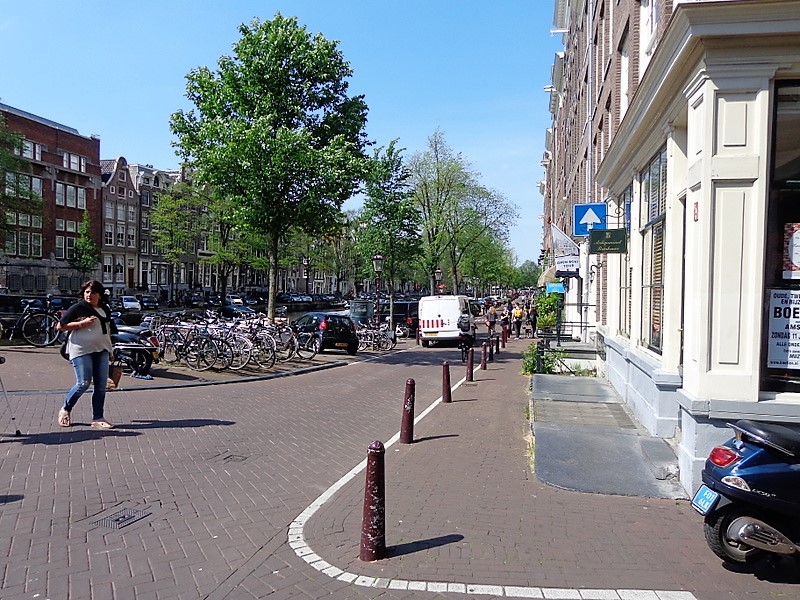 f several sections – narrow pedestrian walks,
wider sections for bicycles, next narrow lanes for the trams with
several coaches that run in both directions. To make walking even more
difficult, it seems like every other store is a restaurant with a
sidewalk café which takes about half of the walkway. Also, there are
many buildings which have a basement with steps leading from the
walkway. Bicycles seem to be the most common way of transportation.
Every street has hundreds of bicycles parked in stands. So it’s possible
to fall off the sidewalk which is elevated above the bike route, and be
hit by tram or a car. Walking around Amsterdam is rather challenging
considering the huge number of people walking in both directions.
f several sections – narrow pedestrian walks,
wider sections for bicycles, next narrow lanes for the trams with
several coaches that run in both directions. To make walking even more
difficult, it seems like every other store is a restaurant with a
sidewalk café which takes about half of the walkway. Also, there are
many buildings which have a basement with steps leading from the
walkway. Bicycles seem to be the most common way of transportation.
Every street has hundreds of bicycles parked in stands. So it’s possible
to fall off the sidewalk which is elevated above the bike route, and be
hit by tram or a car. Walking around Amsterdam is rather challenging
considering the huge number of people walking in both directions.
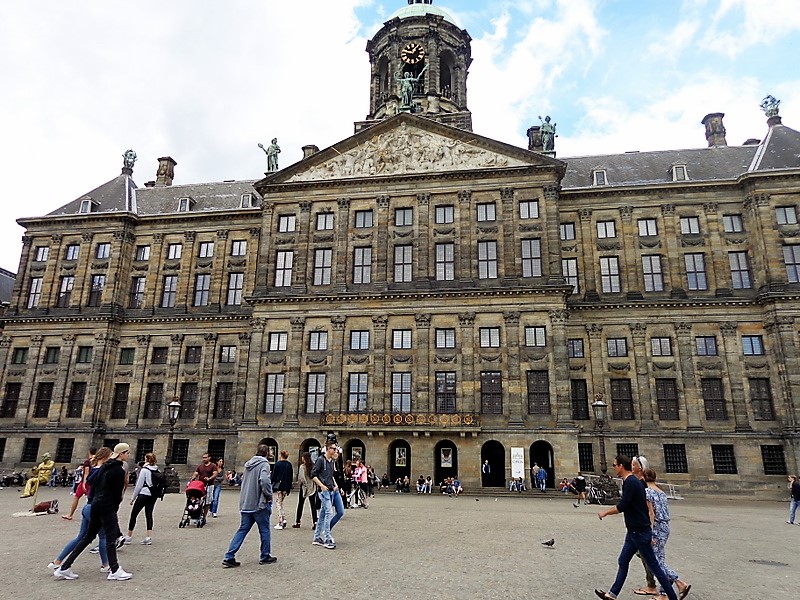 Today,
our first adventure was to visit the Royal Palace which was several
blocks away. The Dutch have called it “ the eighth wonder of the world”.
The palace stands in the oldest square – called Dam Square. When the
Palace was built in 1648, it was to serve as a town hall. In 1808 the
town hall was transformed into a palace. In 1806, Louis Napoleon,
brother of Napoleon Bonaparte, took the throne of Holland and proclaim
Amsterdam its capital. Louis insisted on
Today,
our first adventure was to visit the Royal Palace which was several
blocks away. The Dutch have called it “ the eighth wonder of the world”.
The palace stands in the oldest square – called Dam Square. When the
Palace was built in 1648, it was to serve as a town hall. In 1808 the
town hall was transformed into a palace. In 1806, Louis Napoleon,
brother of Napoleon Bonaparte, took the throne of Holland and proclaim
Amsterdam its capital. Louis insisted on having a residence in the capital and laid claim to the building.
having a residence in the capital and laid claim to the building.
We first entered what is called the Citizens' Hall which, as its
name suggests, was open to all citizens. It was a meeting place for
functionaries, merchants, and citizens from all walks of life. The floor
of the Citizens' Hall had inlaid maps the heavens and the earth by Joan
Bleau (1596 – 1673). The vast open space of the Hall was three
stories high.
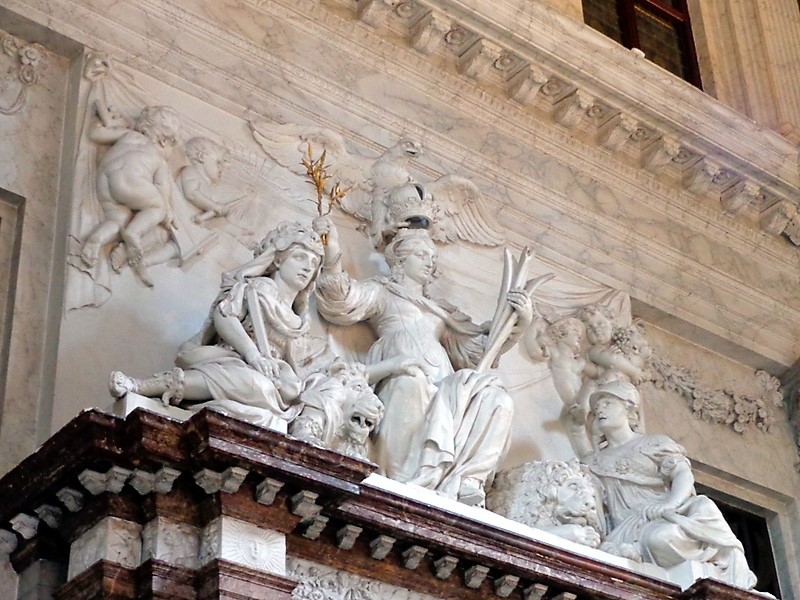 Above
the entrance to the Citizens' Hall is what is called the
"Personification of Amsterdam". She has three crosses on her breast. In
her right hand she holds an olive branch, a biblical symbol of peace,
and in her left a spray of palm leaves, the classical emblem of
prosperity. An eagle approaches to place the crown on her hair, and two
lions lay at her feet. A woman sits on either side of her. One wears the
helmet of Pallas Athena, the goddess of wisdom; the other a lion's skin,
signifying the Greek god Hercules and therefore alluding to strength.
Above
the entrance to the Citizens' Hall is what is called the
"Personification of Amsterdam". She has three crosses on her breast. In
her right hand she holds an olive branch, a biblical symbol of peace,
and in her left a spray of palm leaves, the classical emblem of
prosperity. An eagle approaches to place the crown on her hair, and two
lions lay at her feet. A woman sits on either side of her. One wears the
helmet of Pallas Athena, the goddess of wisdom; the other a lion's skin,
signifying the Greek god Hercules and therefore alluding to strength.
We took an audio tour of 21 magnificent room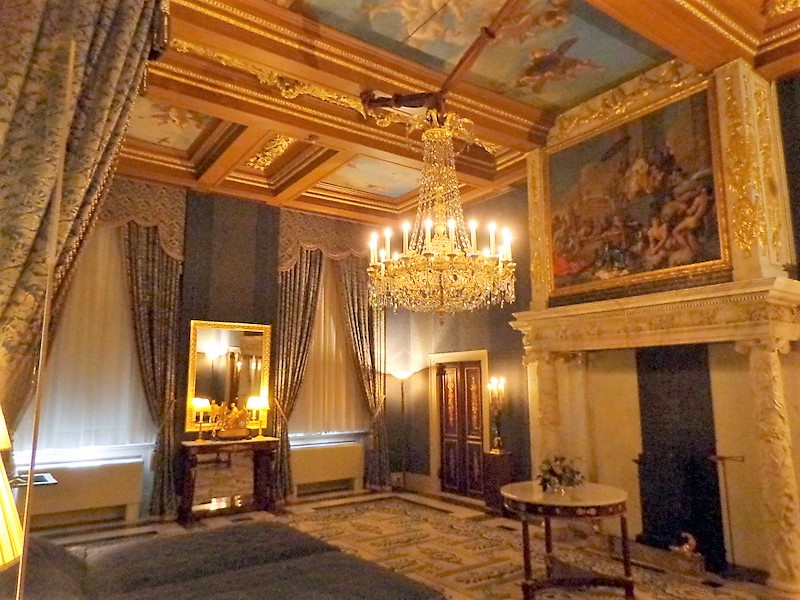 s.
This room is know as the Burgomasters' Chamber. Note the beautiful
ceiling , an example the ceilings of every room. We enjoyed the tour
very much as each room was beautifully furnished with original
furniture.
s.
This room is know as the Burgomasters' Chamber. Note the beautiful
ceiling , an example the ceilings of every room. We enjoyed the tour
very much as each room was beautifully furnished with original
furniture.
NIEUWE KERK
Next door is a church known as
Nieuwe Kerk (new church) which was
built in the 1400s and is the most important church in Amsterdam. It is
open to the public as a church, exhibition space and also holds o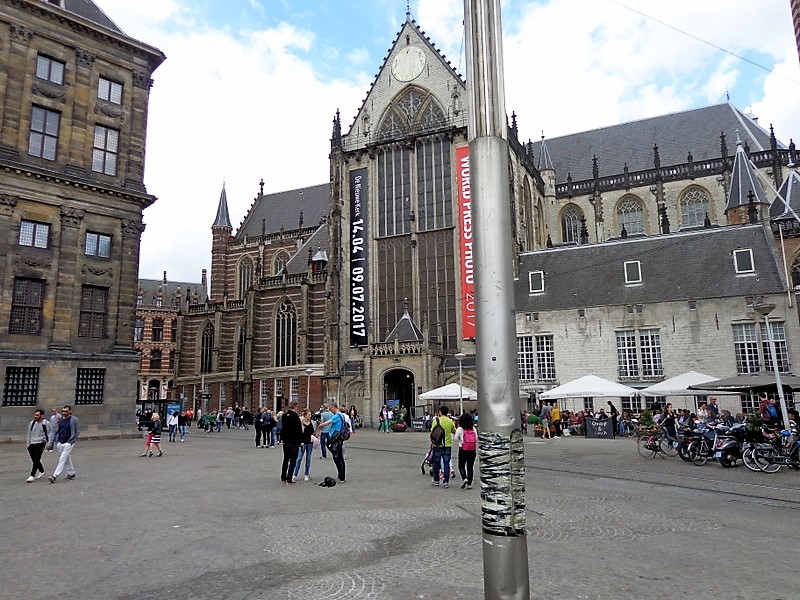 rgan
concerts and private events. The church originally dates from the 14th
century when the growing city of Amsterdam needed a second church from
the Oude Kerk (Old Church). The Nieuwe Kerk was subsequently damaged by
fire a number of times - in 1645 it was rebuilt in Gothic style after
almost being destroyed - and this is what can be seen today along with
some renovations from the 19th and 20th century.
rgan
concerts and private events. The church originally dates from the 14th
century when the growing city of Amsterdam needed a second church from
the Oude Kerk (Old Church). The Nieuwe Kerk was subsequently damaged by
fire a number of times - in 1645 it was rebuilt in Gothic style after
almost being destroyed - and this is what can be seen today along with
some renovations from the 19th and 20th century.
The Nieuwe Kerk is used for royal weddings and inaugurations. On April 30,2013 it was the site of the
investiture of Dutch King Willem Alexander and Queen Maxima, who were
also married in the church in 2002. Highlights inside the church include
the magnificent Great Organ from 1655, the grand brass choir screen and
stained glass windows, and hundreds of grave slabs on the floor
weddings and inaugurations. On April 30,2013 it was the site of the
investiture of Dutch King Willem Alexander and Queen Maxima, who were
also married in the church in 2002. Highlights inside the church include
the magnificent Great Organ from 1655, the grand brass choir screen and
stained glass windows, and hundreds of grave slabs on the floor
Presently the Nieuwe Kerk is hosting the World Press Photo - Annual
exhibition contest of international photojournalism. The World Press
Photo foundation (founded 1955) is based in Amsterdam and has held the
exhibition at the Nieuwe Kerk from 1982-1999 and 2014-present. The
exhibit run from mid-April
 to
early-July.
to
early-July.
We paid €10 each for
entrance to the exhibit, but we wanted to see the church itself. We also
found the exhibit meaningful, many of the photos famous news photographs.
By this time, it was after 1:00 and we were getting hungry. One of
the streets in front palace contained all the standard American fast
food joints so we stopped in McDonald’s which had four floors of tables
and was full. It hit the spot.
Next, we visit a place called – The
Begijnhof which is an enclosed courtyard dating from the early 14th
century. Nothing survived of the earliest dwellings, but the Begijnhof
still retains a sanctified atmosphere. The Begijnhof was originally
built as a sanctuary for the Beguines, a Catholic organization of lay
women who lived like nuns, although they took no monastic vows. Houses
in Begijnhof

The Catholic faith was banned in the 16th century. The Begijnhof was
the only Catholic institution that continued to exist because the houses
were the private property of the women. They did have to give up the
chapel. A new, so-called ‘hidden church’ was later built behind the
facades of several residences. The Begijnhof Catholic
Chapel was completed in 1680.
Across from Catholic Chapel is the
English Reformed Church, which is
one of the oldest buildings in
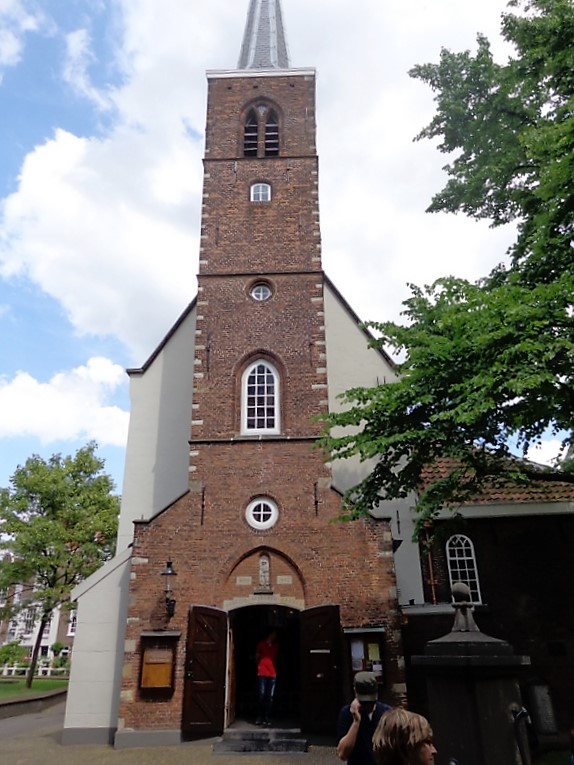 Amsterdam.
It is home to an English-speaking congregation which is affiliated to
the Church of Scotland and to the Protestant Church in the Netherlands.
The church was originally established as Begijnhof's chapel. It was
confiscated from the Catholic lay sisterhood during the Reformation. For
this reason, the church is invisible from the street and can only be
discovered by entering the courtyard through an inconspicuous archway.
Amsterdam.
It is home to an English-speaking congregation which is affiliated to
the Church of Scotland and to the Protestant Church in the Netherlands.
The church was originally established as Begijnhof's chapel. It was
confiscated from the Catholic lay sisterhood during the Reformation. For
this reason, the church is invisible from the street and can only be
discovered by entering the courtyard through an inconspicuous archway.
As with other city churches, the keys of the chapel were surrendered
to the Municipality when Amsterdam sided officially with the Prince of
Orange and formally adopted Calvinist doctrines in 1578. The church,
controlled by the Beguines, was taken by the city council and closed. In
1607, the church was re-opened for worship when t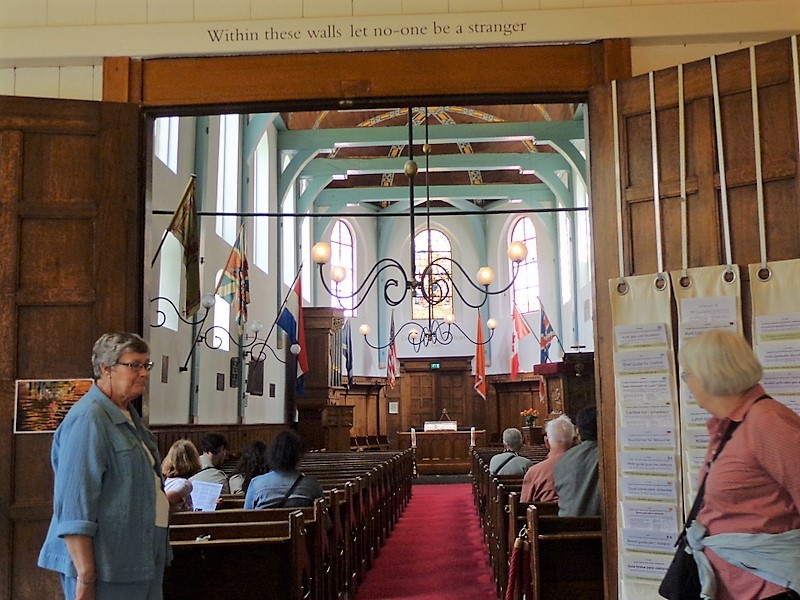 he
Municipality presented it to the English-speaking Protestants living in
the city. Since then, services in English have continued practically
without interruption to the present day. Since the late 1970s, the
church has provided Amsterdam with an important platform for the
performance of chamber music of all periods and styles with over 70
concerts a year. In particular, it has given many young artists the
opportunity to launch their careers. The Academy of the Begijnhof,
founded by a former church organist, is now one of Amsterdam's premier
baroque orchestras.
he
Municipality presented it to the English-speaking Protestants living in
the city. Since then, services in English have continued practically
without interruption to the present day. Since the late 1970s, the
church has provided Amsterdam with an important platform for the
performance of chamber music of all periods and styles with over 70
concerts a year. In particular, it has given many young artists the
opportunity to launch their careers. The Academy of the Begijnhof,
founded by a former church organist, is now one of Amsterdam's premier
baroque orchestras.
After our visit there, time was getting near 5 o’cloc k and we were
getting tired. Our pedometer said that we had walked 4 ½ miles thus far
today so we came back to the hotel.
k and we were
getting tired. Our pedometer said that we had walked 4 ½ miles thus far
today so we came back to the hotel.
We had dinner reservations tonight in a fun restaurant called the
Blue Spoon which was sort of in the area where we were this afternoon.
We shared a salad, Kathleen had a seafood soup with several kinds of
fish plus shrimp and mussels. I had scallops with caramelized endives.
We have several fun activities planned for tomorrow. We walked 6.7 miles
today.
Day 15 coming soon
